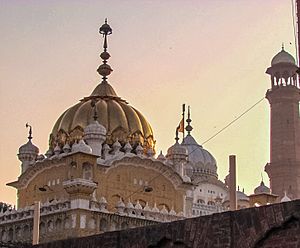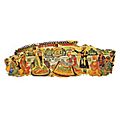Guru Arjan facts for kids
Quick facts for kids Guru Arjan |
|
|---|---|
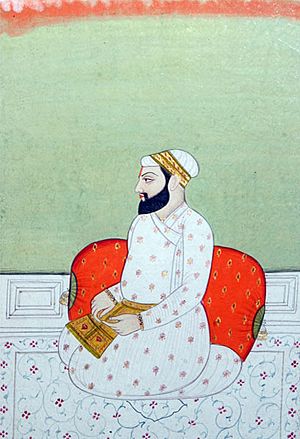 |
|
| Religion | Sikhism |
| Known for |
|
| Other names | Fifth Master Fifth Nanak |
| Personal | |
| Born | 15 April 1563 Goindwal, Mughal Empire (present-day Tarn Taran district, Punjab, India) |
| Died | 30 May 1606 (aged 43) Lahore, Mughal Empire (present-day Punjab, Pakistan) |
| Cause of death | Execution |
| Resting place | Gurdwara Dera Sahib, Walled City of Lahore |
| Spouse | Mata Ganga |
| Children | Guru Hargobind |
| Parents | Guru Ram Das and Mata Bhani |
| Religious career | |
| Title | 5th Guru of Sikhism |
| Predecessor | Guru Ram Das |
| Successor | Guru Hargobind |
| Signature | 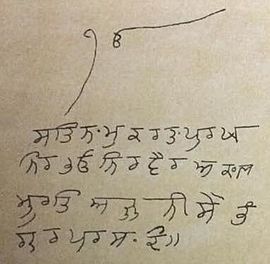 |
Guru Arjan (born April 15, 1563 – died May 30, 1606) was a very important leader in the Sikh faith. He was the fifth of the ten Sikh Gurus. He is remembered as the first Sikh Guru who was martyred, meaning he died for his beliefs.
Guru Arjan created the first official holy book of the Sikhs. This book was called the Adi Granth. Later, it grew into the Guru Granth Sahib, which is the main holy scripture for Sikhs today.
He was born in Goindval, a town in the Punjab region. His parents were Bhai Jetha, who later became Guru Ram Das, and Mata Bhani. Guru Arjan helped finish building the famous Harmandir Sahib in Amritsar. His father, Guru Ram Das, had started the town and built a holy pool there.
Guru Arjan also made changes to how the Sikh community was organized. He encouraged Sikhs to donate a small part of their income or goods. This donation, called dasvandh, helped build gurdwaras (Sikh temples) and langars (free community kitchens).
In 1606 CE, Guru Arjan was arrested by order of the Mughal Emperor Jahangir. He was asked to change his religion to Islam but refused. He was then tortured and died. His death is a very important event in Sikh history. Sikhs remember it every year as Shaheedi Divas of Guru Arjan.
Contents
Early Life of Guru Arjan
Guru Arjan was born in Goindval. His mother was Bibi Bhani and his father was Jetha Sodhi. Bibi Bhani was the daughter of Guru Amar Das, another important Sikh Guru. His father, Jetha Sodhi, later became known as Guru Ram Das, the fourth Sikh Guru.
The place where Guru Arjan was born is now a special memorial called Gurdwara Chaubara Sahib. He had two brothers, Prithi Chand and Mahadev. Most historians agree that he was born on April 15, 1563.
Guru Arjan spent his early years in Goindwal. Then, he lived with his father in Ramdaspur for seven years. Sikh stories say he also spent two years in Lahore. His father sent him there for a family wedding and to help start a Sikh community.
In 1581, after his father passed away, Guru Arjan became the fifth Sikh Guru. He was only 18 years old. This meant that the leadership of the Sikhs stayed within the family of Guru Ram Das.
Becoming the Fifth Guru
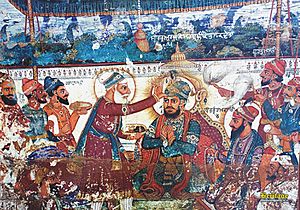
Guru Ram Das chose Arjan, his youngest son, to be the next Sikh Guru. His middle brother, Mahadev, decided to live a simple, spiritual life.
Choosing Arjan as the next Guru caused some disagreements within the Sikh community. Guru Arjan's oldest brother, Prithi Chand, was unhappy with this choice. He created his own group of Sikhs. The Sikhs who followed Guru Arjan called this group Minas, which means "scoundrels."
These disagreements were written about by both sides. The main Sikh tradition recognizes Guru Arjan as the fifth Guru. His son, Guru Hargobind, became the sixth Guru after Guru Arjan's death in 1606.
The Death of Guru Arjan
Guru Arjan died while he was held by the Mughal Empire. This event is a very important and sad part of Sikh history.
Some historians from the Mughal Empire believed Guru Arjan's death was a political event. They said that Sikhs were becoming a strong group. They also thought that Sikh Gurus were getting involved in the politics of the Punjab region. One theory suggests that Guru Arjan supported a rebellious son of Emperor Jahangir. Because of this, Jahangir became angry and ordered the Guru's death.
However, Emperor Jahangir's own writings show he might not have understood the importance of the Sikh Gurus. He saw Guru Arjan as a Hindu leader who was attracting many people. Jahangir wrote that if Guru Arjan did not become a Muslim, the Sikh faith needed to be stopped.
Sikh traditions tell a different story. They say that Guru Arjan's death was part of a larger effort by Islamic leaders in the Mughal Empire to persecute Sikhs. These leaders were worried about the growing number of Sikhs.
In 1606 CE, Guru Arjan was put in Lahore Fort. Sikh accounts say he was tortured and then executed. They state that Emperor Jahangir demanded a large fine and wanted Guru Arjan to remove some hymns from the holy book that he found offensive. The Guru refused to pay the fine or change the hymns. This led to his execution.
Some Muslim accounts from the 19th century describe Guru Arjan as a powerful leader who lived in luxury. However, a Sufi friend of Guru Arjan, Mian Mir, tried to help him when Jahangir ordered his execution.
It is not fully clear how Guru Arjan died. Some scholars say the evidence is unclear whether he was executed, died from torture, or was drowned in the Ravi River. However, Bhai Gurdas, a Sikh writer who lived at the same time as Guru Arjan, wrote that Emperor Jahangir ordered the Guru to be tortured to death.
A Jesuit missionary named Jerome Xavier, who was in Lahore at the time, also wrote about Guru Arjan's death. He recorded that Sikhs tried to pay a large fine to save the Guru, but it did not work. He wrote that Guru Arjan suffered greatly.
Sikh tradition says that before he died, Guru Arjan told his son, Guru Hargobind, to take up arms and fight against unfair rulers. His death made the Sikh community stronger and more determined to resist persecution by the Mughal Empire. It taught Sikhs that being truly religious also means being brave and willing to stand up for what you believe in.
Guru Arjan's Legacy
Amritsar and Community Growth
Guru Arjan's father, Guru Ram Das, started the town of Ramdaspur. This town was built around a large man-made pool called "Ramdas Sarovar." Guru Arjan continued his father's work to build up the area.
The town grew during Guru Arjan's time. This growth was paid for by donations from Sikhs and built by volunteers. The pool area became a temple complex with the famous Harmandir Sahib (Golden Temple) near the water. In 1604, Guru Arjan placed the holy Sikh scripture inside this new temple. This city is now known as Amritsar, and it is the most important pilgrimage site for Sikhs.
Guru Arjan made Amritsar a major place for Sikhs to visit. He also wrote many Sikh scriptures, including the well-known Sukhmani Sahib. He helped build other important projects, like water reservoirs. He also founded new towns such as Tarn Taran, Kartarpur, and Hargobindpur.
Guru Arjan traveled through the Majha and Doaba regions of Punjab. He founded new towns there. Because these towns were in the heart of Punjab, many people, especially farmers, became Sikhs. Guru Arjan was not just a spiritual guide. He also acted as a leader for his followers.
The Adi Granth
According to Sikh tradition, Guru Arjan created the Adi Granth. He gathered hymns from earlier Gurus and other saints. He carefully chose which hymns to include, making sure they were true to the Gurus' teachings. His collection included hymns from the first four Sikh Gurus, his own compositions, and hymns from 17 Hindu and 2 Muslim poets.
This important work was finished on August 30, 1604. It was then placed in the Harmandir Sahib temple on September 1, 1604.
Guru Arjan was a very talented poet. He wrote 2,218 hymns. This means he wrote more than half of the entire Guru Granth Sahib. Scholars say his writings combined spiritual messages with rich language.
After Guru Arjan finished the Adi Granth, Emperor Akbar was told that it contained teachings against Islam. He asked to see a copy of the book.
The Akbarnama, a book about Emperor Akbar, mentions that Guru Arjan met Emperor Akbar in 1598. This meeting might have influenced how Sikh scriptures were written and how the Sikh community later became more focused on self-defense.
After Guru Ram Das, some new hymns appeared that claimed to be written by Guru Nanak. Guru Arjan and his followers believed these hymns were fake or changed. To prevent wrong teachings, Guru Arjan started a big project. He collected, studied, and approved all the hymns. This led to the official written scripture, the Adi Granth, completed by 1604.
The writings of Prithi Chand and his followers were kept in separate Sikh texts. However, the main Sikh community adopted the Guru Granth Sahib, which came from Guru Arjan's work.
Images for kids
-
Guru Arjan compiling the Adi Granth with Bhai Gurdas.
See also
 In Spanish: Gurú Arjan Dev Ji para niños
In Spanish: Gurú Arjan Dev Ji para niños
- Sukhmani Sahib
- Guru Granth Sahib


